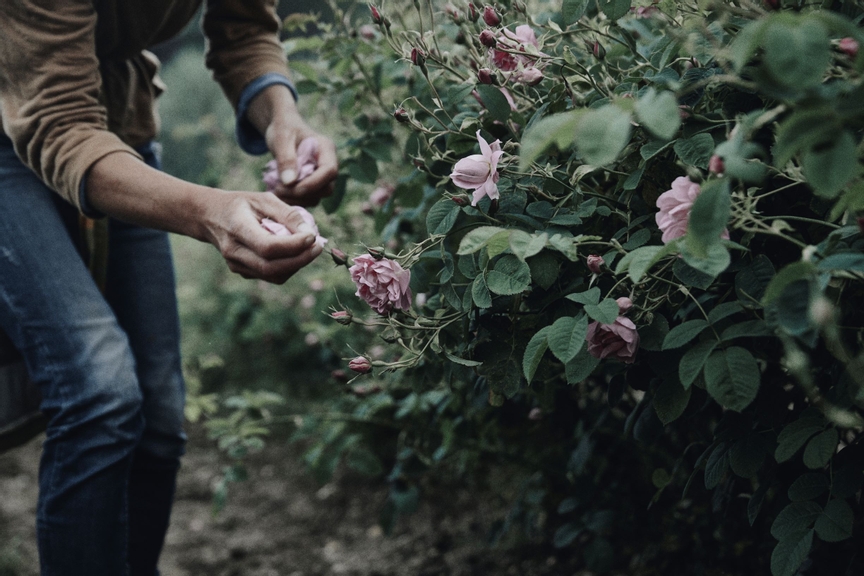The exquisite May rose, also known as the Rose de Mai is a rare and coveted flower that has been cherished for centuries for its beauty and intoxicating fragrance. Though the May rose was first cultivated in ancient Persia, today the flower is synonymous with the French perfume town of Grasse. Let’s explore the history and modern cultivation of this precious bloom.
A History Rooted in Legend
The origin story of the May rose is steeped in myth and legend As the tale goes, during the Middle Ages a Crusader returning from Persia smuggled a bush of the prized roses back home to France by hiding it in the bell of his musical horn. He gifted the flowers to King Thibault IV who then planted the roses in the countryside outside Grasse
While the full truth may be lost to time, records confirm Rosa centifolia, the Latin name for the May rose arrived in Europe by the 16th century. The flower’s delicate pink petals and sweet honeyed aroma quickly made it a star ingredient in perfumes.
The Priceless Petals of Provence
Today, the May rose remains a symbol of the sun-soaked Provence region in southeast France. Each spring, the hillsides around Grasse burst into bloom with thousands of May rose bushes. During the height of the season, which lasts just a few short weeks in May, the perfume of the flowers fills the air for miles.
The May rose requires very specific conditions to thrive. Hot summers, mild winters, and chalky soil create the ideal terroir in Provence. The flower also demands painstaking hand cultivation. Growers prune the bushes throughout the year to encourage abundant blooms.
When the flowers finally emerge in May, specialized rose pickers set out at dawn, while the petals are still crisp with dew. Using a special curved knife, they cleanly cut each flower just as it reaches full bloom. Pickers can harvest up to 10 pounds of petals per hour during the early morning harvest.
From Bud to Absolute
After the May roses are picked, a race against time begins. The freshly cut flowers are immediately spread out on huge sheets and hand-sorted. Damaged, discolored or wilted flowers are discarded. The perfect petals are then distilled, often right in the fields on old copper stills.
It takes a staggering 750,000 May roses to produce just one pound of essential oil. Known as rose absolute, this concentrated elixir retains the truest scent of the living flower. The absolute is then used to create the world’s most luxurious perfumes.
A Future As Precious As the Past
While other regions have tried growing the May rose, none can replicate the magic combination of climate and care that produces the flowers of Grasse. However, the time-honored tradition faces challenges in modern times. As costs climb, perfume houses seek cheaper, synthetic alternatives. Urban sprawl eats away fields where the roses once bloomed.
Still, committed growers and perfumers continue nurturing the May rose. Each flower and drop of absolute is a bottled bit of history. When we dab on perfume scented with those Provence petals, we connect with centuries of passion passed from the crusader’s medieval horn to the modern magic of Grasse.
Majestic and characteristic, spicy, green and honeyed, powerful and rich, both floral and fruity scent, that can evoke litchee.





Bulgaria, France, Morocco, Türkiye


Growing Roses, A Complete Beginner’s Guide
FAQ
Where in the US are roses grown?
Which country produces the most rose?
Where was the rose first cultivated?
Where is the world’s oldest rose located?
Where do wild roses grow?
In North America, wild roses can be found in both the United States and Canada. Cultivated varieties adorn gardens across the continent. Some species have also been introduced to parts of Africa and Australia. The successful growth of roses depends on a combination of climate factors.
Where did roses grow in ancient Rome?
The Romans grew roses extensively in large public gardens, and Rosa alba could be found in the gardens of nobles and monks in medieval Europe, widely thought to have been spread there by visiting Romans. Every medieval monastery had its botanist monk, cultivating roses alongside other plants and herbs to be used in religious ceremonies.
Did medieval gardeners grow roses?
Also grown by medieval gardeners was Rosa damascena, or the damask rose, with its luxuriant double, deeply scented flowers. As its name ‘from Damascus’ suggests it was probably brought back to Europe from Syria by merchants in the 12th century or Crusaders in the 13th century, along with Rosa oficinalis, known as ‘the apothecary’s rose’.
When did roses become a garden plant?
The process of turning the wild rose into a garden plant of infinite variety began a long time ago. The first domesticated roses may have been deliberately cultivated as early as 3,000 BCE in China. They were used in the making of rosewater and in perfumed oils, for medicinal purposes and as confetti for celebrations.
- The Ultimate Guide to Growing Strawberries in Raised Beds - August 8, 2025
- No-Dig Garden Beds: The Easiest Way to Grow a Beautiful Garden - August 6, 2025
- How to Protect and Preserve Wood for Raised Garden Beds - August 6, 2025

